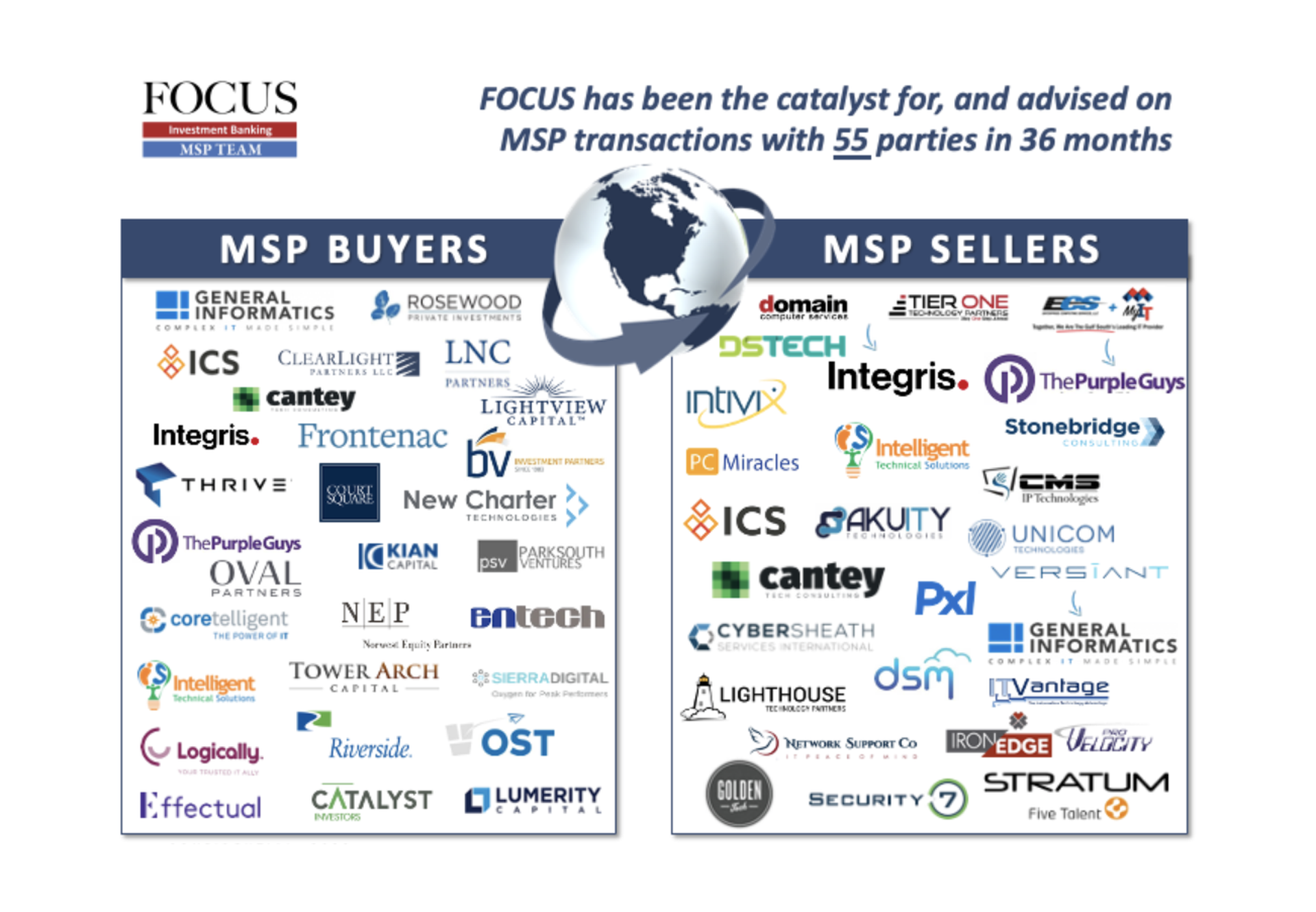Managed Service Provider Valuation and M&A with Private Equity
As a managed service provider (MSP) owner, you have put in years of hard work and dedication to build a successful business. If you’re vehemently opposed to ‘leaving money on the table’ and are contemplating selling equity for the first or second time (e.g. a ‘recapitalization’), this article is for you.
Having advised on MSP transactions with 55 parties over the past three years, we are frequently asked to share ‘Pro Tips’ to avoid leaving money on the table. While we are happy to do that, many are even more amazed to hear how multiple clients have used our Team’s proprietary sell side (sale) process to create and get paid at closing for ‘New Value.’
Here are five (5) Pro Tips, listed in order of best place to start:
1. Be very selective about the MSP M&A advisory team that will represent your MSP
“We’ll remove your car for cash.”
Don’t laugh – as MSP M&A advisors, it is astounding to us how many MSPs have sold their life’s work to our industry’s largest private equity (PE) consolidator because it was the first offer they received.
Pro Tip #1: If you can say ‘no’ to their/any first offer, your likelihood of ‘success’ (defined as a better financial, cultural, strategic, and geographic ‘fit’) may increase exponentially.
For example, here are a couple of comments from our clients1:
- Just a year ago, (name redacted) quoted me 5.0x EBITDA2. When I mentioned that I might hire FOCUS’ MSP Team, (name redacted) made a verbal and written offer of 7.0x EBITDA to entice me not to. I believe the major value proposition your firm offers is the ability to hold an auction with hungry PE firms. Ideally, we can leverage offers, so we can force the Buyer we want to improve their offer. Without an auction, we have no leverage over our favorite buyers. …with you and your contacts, I am hoping for a 10.0x or higher. Founder/ CEO of financial services-focused MSP
- With them (FOCUS’ MSP Team) negotiating the deal, I was able to get a price almost 50% higher than I thought likely, and with a buyer who is a great cultural fit. Founder / CEO of a vertical agnostic-focused regional MSP
Advisory Team Selection Criteria:
“DON’T hire my team!”
- In the same way, we encourage you not to take the first offer; we’d also encourage you to challenge our Team and, more importantly, our competition during the selection process. So here is what to ask:
- Can you show me fifteen (15) inbound emails you received over the past 30 days from PE buyers who are specifically searching for MSP add-on/ platform assets?
- Can you connect me with 50+ MSP buyer/seller references you’ve transacted with over the past 36 months?

4. For which references have you built an MSP M&A pipeline as part of the sell-side process?
5. Can you show me how many MSP ‘Merger of equals’ transactions your Team has been the catalyst for/advised on and how much ‘New Value’ it created for your clients?
6. How many people on your Team spend 100% of their time executing MSP transactions?
7. What valuation do you expect for our MSP in a sales process, and why?
8. Can you show me how much you will charge relative to the value you will provide?
9. Tie Breaker: Which MSP Team Leader has done the best job of marketing themselves and their Team (# of MSP speaking engagements, articles written, webinars, times quoted this year, LinkedIn followers)? All drive I. above, and these are the same skills required to help you reach the largest, and most qualified group of buyers and, most importantly, maximize transaction value.
2. Determine GAAP EBITDA
“Love the fact that they are getting a real read on EBITDA. Will help us to be more competitive for sure.” CFO of PE-backed MSP platform seeking acquisition targets
Almost every MSP that comes to ‘the market’ for the first time will not have financial statements prepared by GAAP3. For example, suppose you enter a negotiation and agree to sell your MSP to someone for a specific price without knowing your GAAP numbers. In that case, both parties risk a major ‘repricing’ event when the actual GAAP numbers are uncovered during the Buyer’s Q of E4 (typically about 30 days after the LOI5 is signed.)
The ‘repricing’ risk is so significant that buyers regularly refuse to start their lawyers on the purchase and other critical agreements until they are confident that the amount of EBITDA you said you have, is confirmed (within a range of plus or minus ~7.0%) by the Buyer’s Q of E report.
We like to tell our clients to try and manage EBITDA expectations to ‘land the plane’ in the weeks leading up to close with a positive surprise to the monthly forecast (as opposed to a negative surprise) to minimize the possibility of a buyer ‘re-trade.’
Pro Tip #2: Our Team has several suggestions to help with these efforts, and as part of our process, we will be talking about ways to help reduce the risk of a buyer re-trade after the LOI is signed.
3. Pursue Opportunities to Create ‘New Value’ During the Sale Process:
Pro Tip #3: Be open to merging with an MSP in your Peer Group6 or one with complementary strengths that FOCUS can introduce you to to increase pro-forma EBITDA and valuation multiples:
Given the scarcity of fully-integrated MSP Platform assets of size (e.g. $2.5MM EBITDA, $5.0MM EBITDA, and $15.0MM EBITDA are the most common requests we get), ‘mergers of equals’ have become commonplace.

- 83% of the PE-backed ‘Merger of Equals’ that FOCUS advised belonged to a Peer Group
FOCUS’ MSP Team currently has 66 PE groups ‘In line’ to find an MSP Platform investment at each significant inflection point of demand, including $2.5MM EBITDA, $5.0MM EBITDA, $15.0MM EBITDA and $25.0MM EBITDA.
- PE buyers with a strong thesis mandate/conviction to invest and want to ‘jump’ up in line may request a non-exclusive buy side letter. Requests are filled on a first come (date engagement letter signed), first served basis.
Pro Tip #4: Create an M&A Pipeline for the Buyer to ‘Buy Their Multiple Down’ after Acquiring Your MSP
- Example #1: A new Platform with $3.0 million of EBITDA seeking 10.0x EBTIDA comes to market with a pipeline of three (3) $1.0 million EBITDA add-ons in signed LOI that it can acquire for 7.0x EBITDA. Because there is a path for the Buyer to ‘buy its multiple down’ to 8.5x (after it has received the second $3.0 million in EBITDA for 7.0x EBITDA), it will be much easier for multiple buyers to rationalize paying 10.0x (or more) for the first $3.0 million of EBITDA.
- Example #2: A Platform with $15.0 million of EBITDA seeking 15.0x EBTIDA comes to market with a pipeline of three (3) $5.0 million EBITDA add-ons in signed LOI that it can acquire for 11.0x EBITDA. Because there is a path for the Buyer to ‘buy its multiple down’ to 13.0x (after it has acquired the second $15.0 million in EBITDA for 11.0x EBITDA), it will be much easier for multiple buyers to rationalize paying 15.0x (or more) for the first $15.0 million of EBITDA.

4. First Impressions as Your MSP Comes to Market ‘Matter.’
- I believe the major value proposition your firm offers is the ability to hold an auction with hungry PE firms. Ideally, we can leverage offers, so we can force the Buyer we want to improve their offer. Without an auction, we have no leverage over our favorite buyers. Founder/ CEO of financial services-focused MSP
Why not put your MSP’s best foot forward and leverage the personal relationships, brand, reputation, and goodwill that FOCUS’ MSP Team has established in the market.
Pro Tip #5: Ask your MSP advisory team engagement leader to personally launch & ‘make the market’ in your auction process.
Conclusion
In conclusion, selling your managed service provider (MSP) can be a complex process, but there are steps you can take to ensure that you get the best possible price and create new value during the sale process. The five pro tips outlined in this article include being very selective about the MSP M&A Advisory team that represents you, determining GAAP EBITDA, pursuing opportunities to create ‘new value’ during the sale process, creating an M&A pipeline for the Buyer to ‘buy their multiple down’ after acquiring your MSP, and ask FOCUS’ MSP Team to launch and ‘make the market’ in your auction process.
By following these five (5) Pro Tips, you may maximize your chances of success, avoid leaving money on the table, and ideally create New Value during the sale process instead of having your “car removed for cash.”
About the author
Abe Garver leads the MSP Team at FOCUS Investment Banking which has been ranked the #1 Lower Middle Market Investment Bank by Axial. He authored ChannelE2E’s PE 101 for MSPs – Part 1 New Platforms Explained, and Part 2 – Add On Managed Service Acquisitions.
Over the past 36 months, his Team has catapulted ten MSPs into “new platforms” for PE sponsors and advised on MSP transactions with 55 parties. Over the course of his career, he has worked on sell-side, buy-side, and capital-raise assignments with approximately 150 clients, including public, private, and fastest-growing members of the MSP501 & CRN 500.
In addition to his work as an M&A investment banker, Abe is a magazine contributor, television commentator, and conference speaker who has published over 125 articles in numerous publications, including FORBES, Seeking Alpha, ChannelE2E, and Yahoo! Finance.
Mr. Garver may be reached at [email protected] or 646-620-6317
1These testimonials may not represent the experience of all clients; testimonials are not a guarantee of future performance or success.
2EBITDA is net income (earnings) with interest, taxes, depreciation, and amortization added back.
3Generally accepted accounting principles (GAAP) refer to a common set of accounting rules, standards, and procedures issued by the Financial Accounting Standards Board (FASB). U.S. public companies must follow GAAP when their accountants compile their financial statements.
4A Quality of Earning report, also called a QOE or Q of E report, helps investors understand the historical earnings and forward-looking performance of the business through rigorous financial analysis. QOE reports are one of the two most essential components of due diligence when buying a company (the other being legal diligence.)
5A letter of intent (LOI) is a document declaring the preliminary commitment of one party to do business with another. The letter outlines the chief terms of a prospective deal.
6Examples of MSP peer groups are The IT Nation Evolve by ConnectWise and TrueMethods by Kaseya.
By Abe Garver, MSP team leader & managing director at FOCUS Investment Banking. Read more guest blogs from FOCUS here. Regularly contributed guest blogs are part of ChannelE2E’s sponsorship program.



